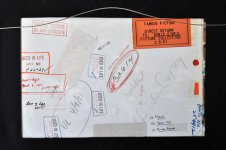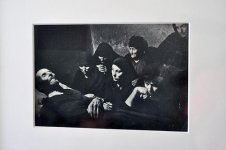jim_jm
Well-known
Bill -
Just saw the Eugene Smith Jazz Loft documentary and thought it was great. Thanks for the heads-up here on RFF!
This got me to thinking about some questions I have had for awhile about a Gene Smith print I purchased several years ago of the "Spanish Wake" image. I haven't been able to track down any more insight about it, so I thought if anyone had any knowledge, it would be you.
I bought it from a local gallery that was working with Life magazine to sell off their physical print archives. They also had images by Robert Capa, Eisenstadt, Bourke-White, among others. But Smith is my favorite photographer and when I saw what was documented on the back of the print, I couldn't pass it up. Attached are images of the back of the print (it's been matted with a plexiglass backing), and of the front (shot at an angle to avoid reflections).
My understanding is that this was called a "press print", which was a working print kept on file until needed for an issue of Life or some other publication or book. Like a library book, it is stamped with the date and name of the publication when checked out, and must be returned to the Life archives when done. My print is creased and has some scuffs, so it's definitely not museum quality. But it's the documentation on the back and the historical record of where this piece of paper has been that's of value to me. I don't think this is signed by Smith, as nothing on the back appears to match his signature.
To get to the point, my questions are:
- Would Life magazine have had several prints of this image in their archives? I would think so in case one was damaged or lost.
- It's written on the back that this print is from a copy of the negative. I had read that Gene would work on his final approved version of the print, and then that print would be photographed to create a "master copy" negative. This negative would then be kept by Life to make new prints if needed by their staff printers. Do you think this would have been the case here?
- I'd like to hope this was the print used in the 4/9/51 issue of Life, when the Spanish Village story was first published, and it is marked on the back with that date several times. However I recall the gallery owner stating she thought this print was made in '61, but wasn't positive.
In any case, thanks for your time, expertise and any answers you can provide. It's much appreciated!
Also, if any RFF members have anything to share or contribute, please do!
Thanks,
Jim Martin
Just saw the Eugene Smith Jazz Loft documentary and thought it was great. Thanks for the heads-up here on RFF!
This got me to thinking about some questions I have had for awhile about a Gene Smith print I purchased several years ago of the "Spanish Wake" image. I haven't been able to track down any more insight about it, so I thought if anyone had any knowledge, it would be you.
I bought it from a local gallery that was working with Life magazine to sell off their physical print archives. They also had images by Robert Capa, Eisenstadt, Bourke-White, among others. But Smith is my favorite photographer and when I saw what was documented on the back of the print, I couldn't pass it up. Attached are images of the back of the print (it's been matted with a plexiglass backing), and of the front (shot at an angle to avoid reflections).
My understanding is that this was called a "press print", which was a working print kept on file until needed for an issue of Life or some other publication or book. Like a library book, it is stamped with the date and name of the publication when checked out, and must be returned to the Life archives when done. My print is creased and has some scuffs, so it's definitely not museum quality. But it's the documentation on the back and the historical record of where this piece of paper has been that's of value to me. I don't think this is signed by Smith, as nothing on the back appears to match his signature.
To get to the point, my questions are:
- Would Life magazine have had several prints of this image in their archives? I would think so in case one was damaged or lost.
- It's written on the back that this print is from a copy of the negative. I had read that Gene would work on his final approved version of the print, and then that print would be photographed to create a "master copy" negative. This negative would then be kept by Life to make new prints if needed by their staff printers. Do you think this would have been the case here?
- I'd like to hope this was the print used in the 4/9/51 issue of Life, when the Spanish Village story was first published, and it is marked on the back with that date several times. However I recall the gallery owner stating she thought this print was made in '61, but wasn't positive.
In any case, thanks for your time, expertise and any answers you can provide. It's much appreciated!
Also, if any RFF members have anything to share or contribute, please do!
Thanks,
Jim Martin



